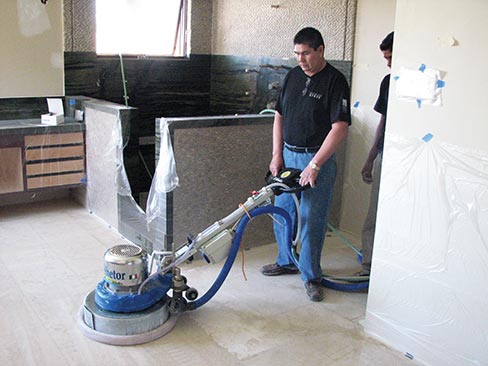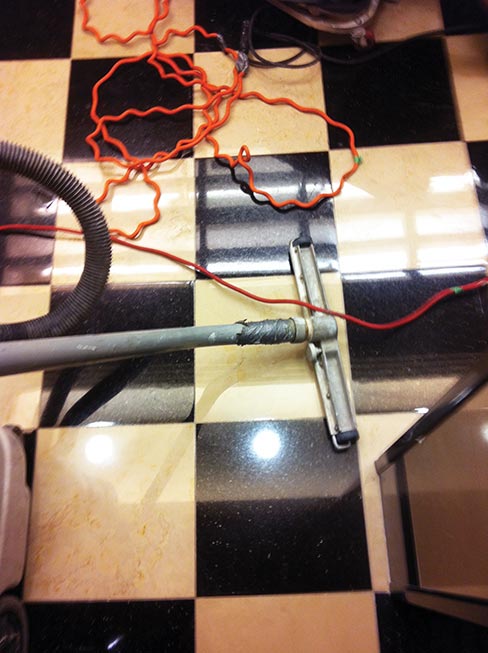The Polished Perspective – Good Housekeeping
Tom McNall
Floor Restoration Consultant
I f you ask any of my restoration technicians what my number one pet peeve on a job is, they’ll tell you that it’s seeing spaghetti.
f you ask any of my restoration technicians what my number one pet peeve on a job is, they’ll tell you that it’s seeing spaghetti.
Now, considering we are in an industry that was perfected and promoted heavily by the Italians, you’d think that I was being a little unfair. That would be true if I was referring to a pasta dish, but on a job site, when I say spaghetti, it means cords and hoses all tangled up and all over the place.
 Nothing gets my Irish up on a job more than seeing unkempt messes that A) look unprofessional, B) create safety concerns, and C) look unprofessional. From that, you should see what is foremost in my mind when I show up on a job. My crews must look professional when working on a customer’s property. And I do not care if they are working in a lakeside mansion or in a head office in a far corner of a basement on a weekend when no one is around – they must always present a clean and safety-oriented workspace.
Nothing gets my Irish up on a job more than seeing unkempt messes that A) look unprofessional, B) create safety concerns, and C) look unprofessional. From that, you should see what is foremost in my mind when I show up on a job. My crews must look professional when working on a customer’s property. And I do not care if they are working in a lakeside mansion or in a head office in a far corner of a basement on a weekend when no one is around – they must always present a clean and safety-oriented workspace.
Now, understanding that on a stone restoration job site we need water, electricity and vacuums, that means that there are at least 3 separate cords or hoses to keep track of and to keep neat. They usually come from at least two different locations and all require certain care and considerations.
Electrical cords that are all tangled up not only provide serious tripping hazards, but they need to be kept away from water as well to prevent electrocution. If you have a wet floor and a 220V connection that can “accidentally” be pulled or slide into a puddle, you could light yourself up like the Christmas tree at Rockefeller Center in New York.
Preventive care needs to be exercised so as to plan ahead and get watertight connections or to buy/make a connection that cannot come in contact with water.
Another potential electrical and water hazard scenario that anyone in the restoration business should recognize is the humble mop bucket. When you are polishing stone, you need mop buckets for laying out water to add polish compound, and for rinsing and cleaning up. A jumble of cords means that you will be lifting buckets over cords numerous times.
For what may seem to be such a small task, it is one where steady balance and firm footing is needed so as not to trip and spill the bucket. Also, mop buckets are not usually ergonomically designed to eliminate lower back strain in lifting. So if you have a young technician or apprentice who is standing on a mess of cords and needs to keep bending and lifting, bending and lifting, you increase the chances of 1) a twisted ankle, from rolling off loose cords and 2) lower back problems because they are not bending to lift the bucket properly or 3) both!
And of course, there will always be the workers who try to roll the buckets over the cords which can damage electrical cords and can tip the bucket over as well, leading to possible water damage, electrocution and basically make you and/or your staff look like a bunch of monkeys seducing a football. All can be prevented by keeping cords neat, straight and organized.
As well, tangled cords are a pain when you are running several different electrical machines and you blow a fuse. Needing to switch outlets becomes a lesson in frustration when you cannot determine which fuse has blown and which one of the spider-webbed mess of cords is which, not to mention the time wasted detangling them to switch to a new outlet.
Water hoses require similar attention to detail. Kinks in the hose can slow down production and are even harder to get out if they are all tied up with electrical cords – not to mention being a serious electrical hazard.
You also want to avoid a water hose bursting because someone rolled the wheels of a heavy piece of equipment over it and sliced it. Again, this can cause water damage to a customer’s home and business and in no way makes you look professional. Neither will making the 6 o’clock news because you electrocuted someone if it sprays an electrical panel or a bypass connection that many so-called “professionals” utilize in this industry.
Vacuum hoses, while not as fatal as the first two items, can make you look professional if handled properly, as well. Because most restoration techs, while polishing or grinding, will work walking backwards (to avoid walking in compounds and to easier navigate lippage), having bulky vacuum hoses in your path and out of your sight line can easily become a tripping hazard as well. The last thing you want is for a restorer falling over backwards and the handle of a 200+ pound machine going through the drywall.
Vacuum hoses are also made with ridges on them, so if you are dragging them around a corner, they act like a mild saw and can wear off paint, drywall and wallpaper. This in no way makes you look professional.
Personally, I prefer to keep all my hoses and cords that hook up to our machines tied up together with Velcro loops for the first 10-12 feet and run them between both legs so as to know where they are and keep them straight in my working area.
From there, the Restoration Assistant or apprentice will always keep an eye on the lead restorer to make sure his path is clear of any obstructions. My Lead Restorers are also taught to do a type of shuffle as they move backwards so they can “feel” for cords and hoses in their backward path instead of tripping on them.
It’s the little things that make the difference, my friends, and when it comes to cord and hose management, an ounce of prevention is definitely worth a pound of cure.
Until next month, keep your stick on the ice!
Tom McNall is founder and owner of Great Northern Stone, an Ontario-based stone cleaning and restoration company servicing Ontario and Chicago, IL. Tom also offers corporate and private consultations as well as speaking at conventions. He can be reached at tom@greatnorthernstone.com.